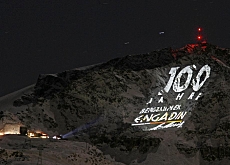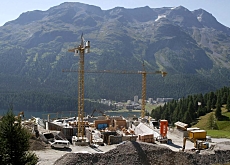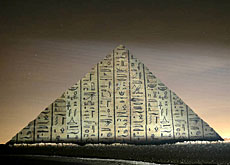Controversy over giant screen in Engadine

Environmentalists have criticised a publicity campaign which uses a mountain face as a giant screen in the upmarket resort of St Moritz in southeastern Switzerland.
A local railway company is using a light machine to project a picture the size of four football pitches against Piz Corvatsch in the Engadine valley.
The Foundation for Environmental Protection called for an immediate halt to the campaign which runs during evening hours through the week until February.
A statement said the environment at Piz Corvatsch was a protected area. It also criticised the use of electricity to project a picture of 27,000 square metres for a local authority which is keen to stress its sustainable energy use.
The organisation warned that the campaign – to mark the 100th anniversary of the Engadine/St Moritz Mountain Railway company – could set a precedent and pave the way for a commercialisation and of the Alpine environment.
It described the giant picture as light pollution which ridiculed nature and set a bad example for tourists.
They said the view of the night skies must not be obstructed.
The protest follows similar criticism last week by the local chapter of the National Heritage Foundation as well as the director of the cantonal environment department and local residents in the region.
Guinness Book of Records
The local authorities of Silvaplana have approved the campaign, which began ten days ago.
The director of the railway company said they also let organisers of a sports event use the advertisement space on the mountain face later this month.
The company has applied to have the illuminated logo entered in the Guinness Book of Records.
The picture measures 167 metres by 167 metres and is projected by a 12,000 watt machine from the middle station of the Corvatsch railway at an altitude of about 3,000 metres.
swissinfo with agencies
The Federal Environment Office has warned of serious damage to nature by light emissions.
It said there is scientific proof that artificial light can have a negative impact on the health of humans and animals.
The light reduces the habitat of night-active animals which can have fatal consequences.
About 20% of the world’s population – and half of the population in western Europe – can no longer see the Milky Way with their naked eye as a result of light pollution.

In compliance with the JTI standards
More: SWI swissinfo.ch certified by the Journalism Trust Initiative


You can find an overview of ongoing debates with our journalists here . Please join us!
If you want to start a conversation about a topic raised in this article or want to report factual errors, email us at english@swissinfo.ch.